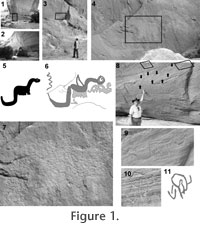|
|
|
INTRODUCTIONThe findings of mainstream geology have firmly established that non-avian dinosaurs became extinct 65 million years ago when the Mesozoic Era gave way to the Cenozoic Era, and that Homo sapiens appeared less than one million years ago. Young-earth creationists, on the other hand, insist that humans, dinosaurs, and all other terrestrial animals were created on the same day about 6000 years ago (e.g., papers in Ham 2006, 2008). They have therefore long sought evidence for the coexistence of humans with dinosaurs and other pre-Pleistocene organisms so as to cast doubt upon the mainstream geological timescale of millions of years. Several such pieces of "evidence" appeared in the twentieth century, only to be discredited upon scrutiny. Alleged human footprints in Mesozoic strata have been exposed as forgeries in some cases and identified as dinosaur tracks in others (Neufeld 1975; Kuban 1989). An alleged sandal print on a Cambrian trilobite has been identified as a weathering pattern (Stokes 1986). An alleged fossilized, Cretaceous human finger has been identified as the infilling of a burrow (Isaak 2007). Alleged Mesozoic sediment encrusting a hammer has been identified as a recent concretion (Isaak 2007). A human skeleton that allegedly came from Jurassic sediment has been identified as an intrusive burial (Strahler 1999). An alleged Miocene deposit on Guadeloupe in which a human skeleton was found has been shown to be a Quaternary deposit (Strahler 1999). The Ica Stones, upon which are images of dinosaurs that were allegedly made by ancient inhabitants of present-day Peru, have been exposed as forgeries (Isaak 2007). The Acámbaro figures, which include dinosaur statuettes allegedly made by ancient inhabitants of present-day Mexico, have been exposed as forgeries (Di Peso 1953).
The four alleged dinosaur depictions are part of a plethora of images made by prehistoric cultures at the Kachina Bridge site. Kachina Bridge is an immense sandstone formation resembling an archway over 60 m high and wide, formed by the undercutting of a rock wall by flowing water. The images comprise rock paintings (composed of pigments) and petroglyphs formed by pecking, abrading, incising, and scratching. Earlier examples are associated with Archaic era hunter-gatherers that occupied the study area generally prior to 1000 B.C. Other images are for the most part attributed to Ancestral Pueblo farming societies (Basketmaker II–Pueblo III) dating from approximately A.D. 200 to 1300. Some petroglyphs may have been made by more recent protohistoric or historic Paiute, Ute, or Navajo groups (Grant 1978; Schaafsma 1980; Cordell 1984; McVickar 2001; Cole 2009; Spangler et al. 2009). |
|
